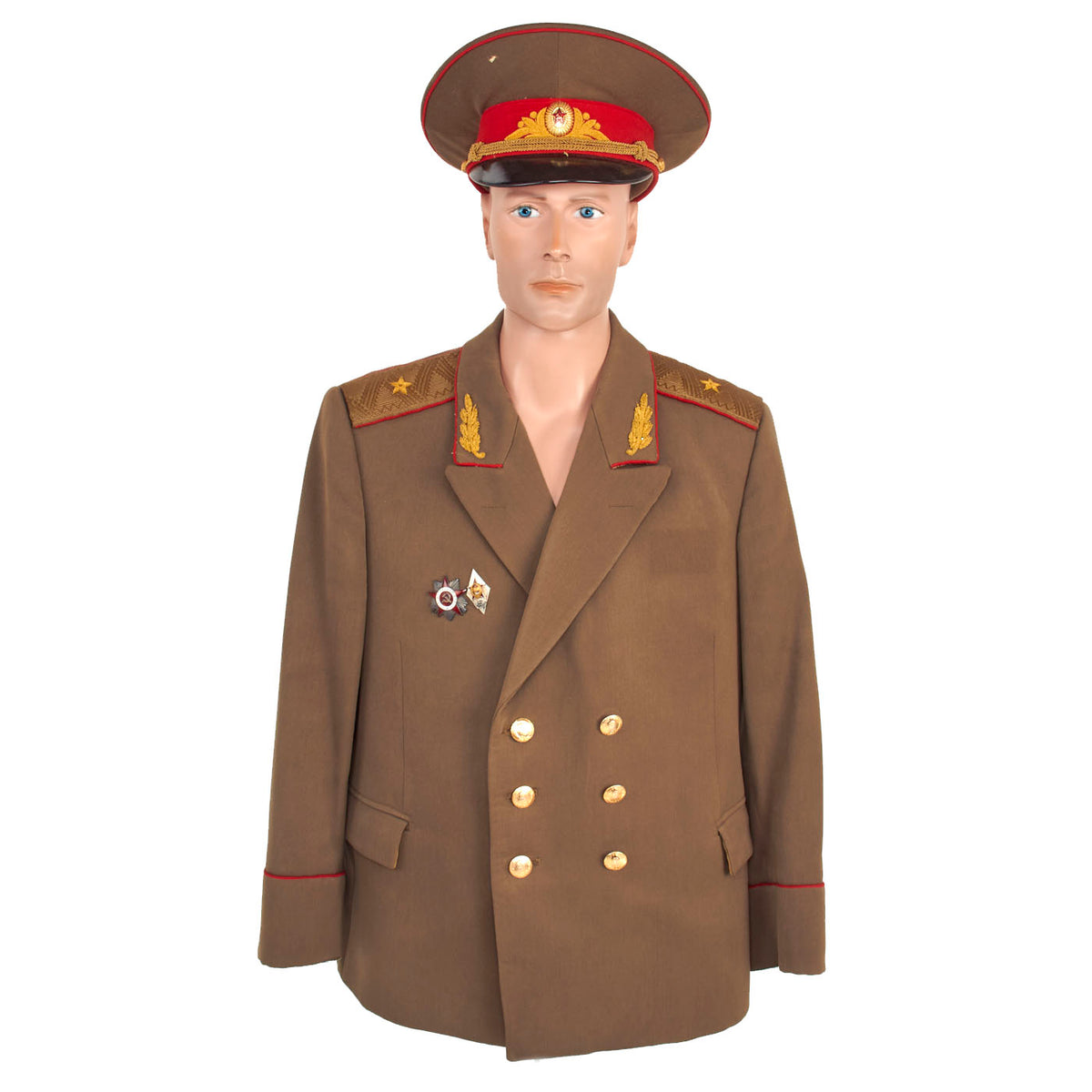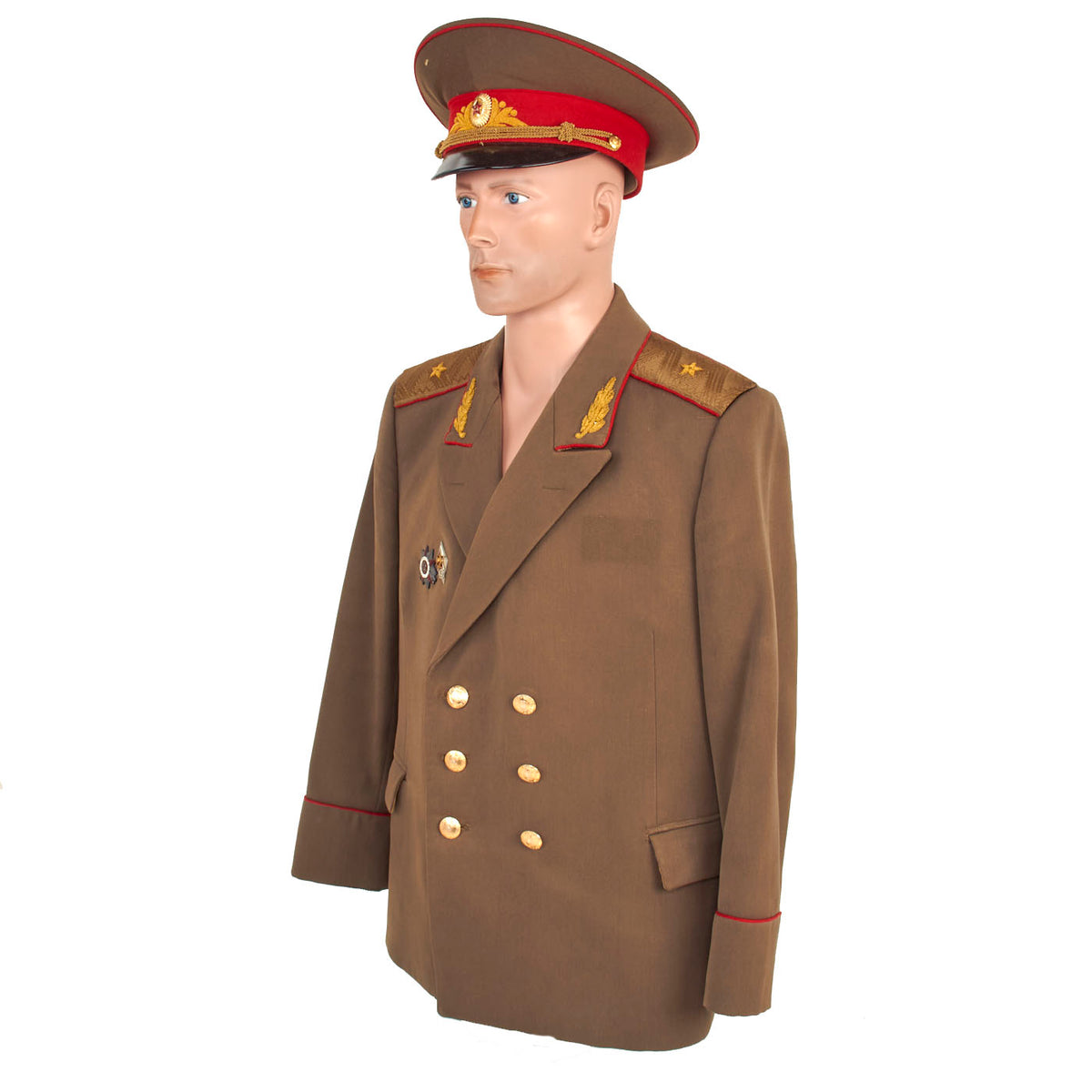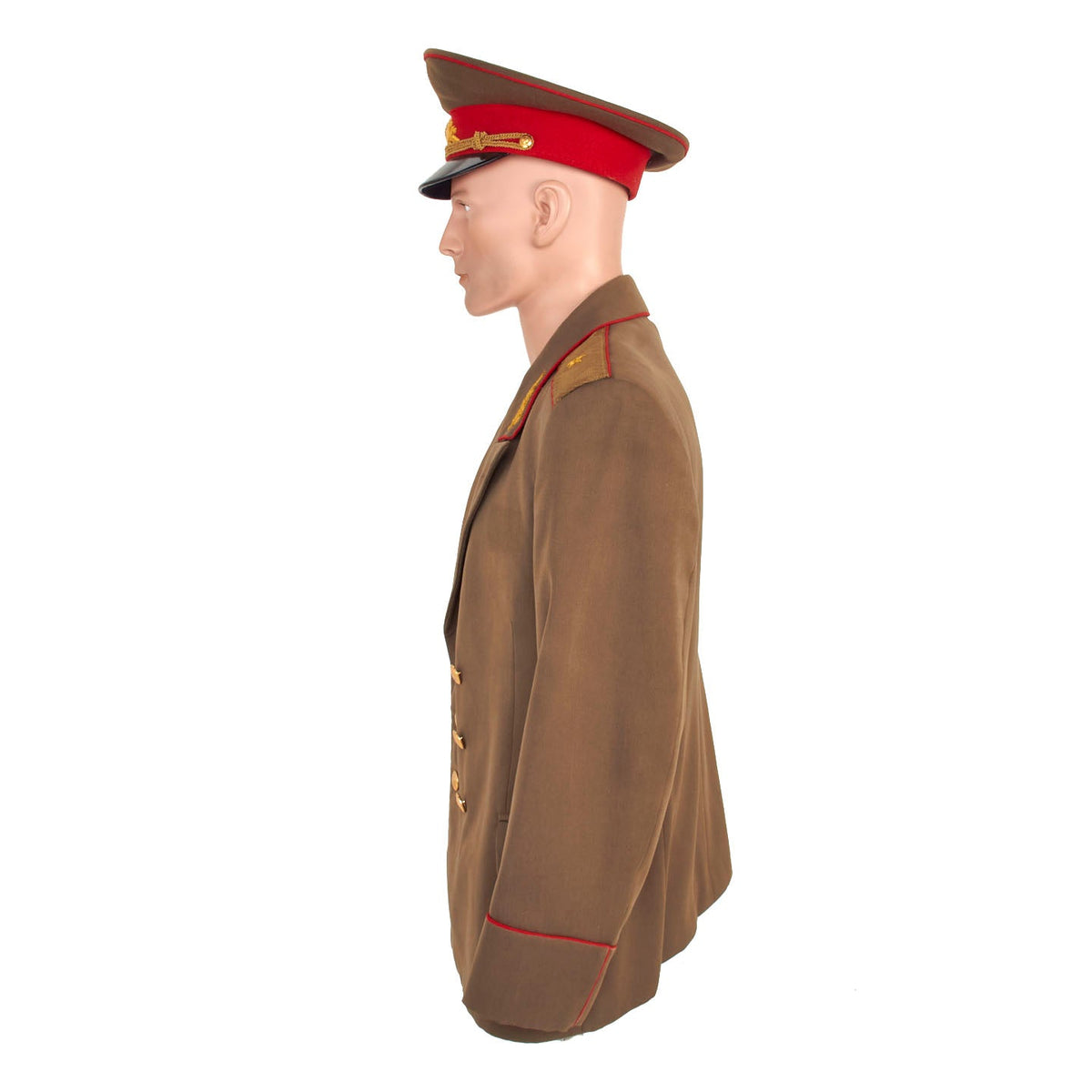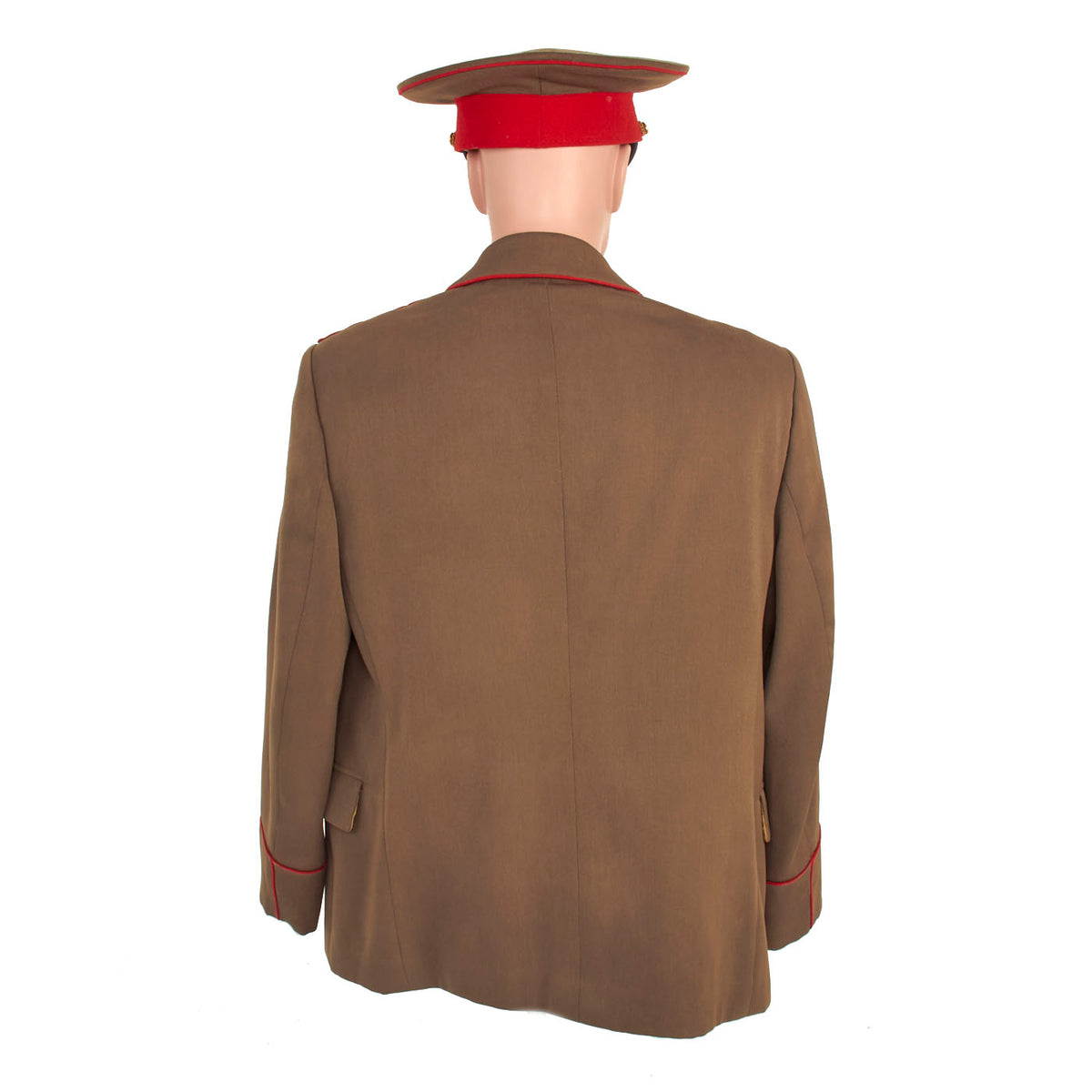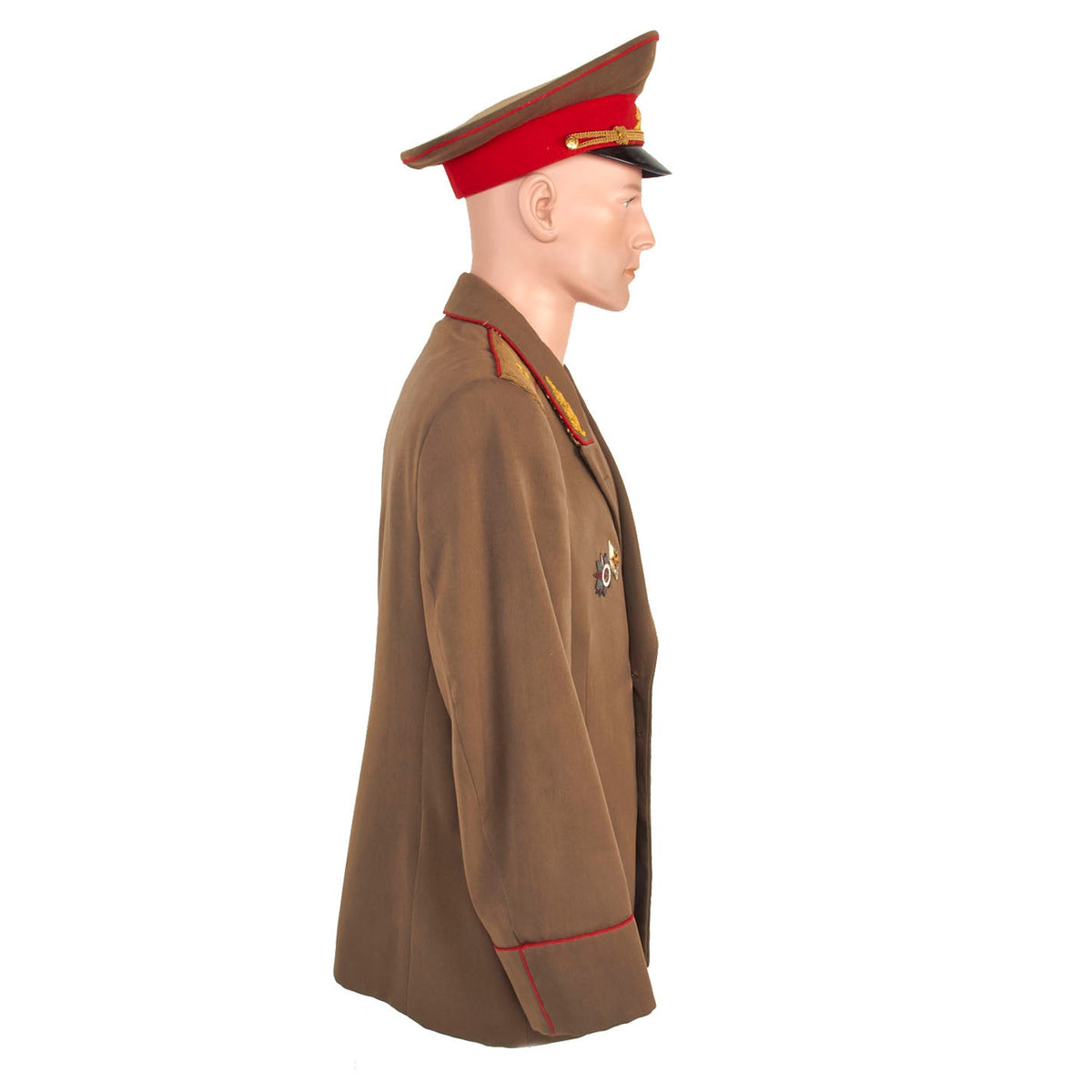Original Cold War Soviet Major General Dress Uniform with Trousers and Cap – WWII Veteran Original Items
$ 325,00 $ 97,50
Original Items: Only One Available. Cold War, circa 1980s Major General’s Uniform Grouping with awards. There are matching Major General’s Rank Boards on each shoulder. Comes with matching General’s trousers with inseam stripes and corresponding General’s Visor Cap.
The Awards Featured
– Order of the Patriotic War 2nd Class: The Order was established on 20 May 1942 and came in first class and second class depending upon the merit of the deed. It was the first Soviet order established during the war, and the first Soviet order divided into classes. Its statute precisely defined, which deeds are awarded with the order, e.g. shooting down three aircraft as a fighter pilot, or destroying two heavy or three medium or four light tanks, or capturing a warship, or repairing an aircraft under fire after landing on a hostile territory, and so on, were awarded with the first class. It was also given to some allied troops and commanders, including western allies. All together, over 324,903 of the 1st class and 951,652 of the 2nd class were issued during the war. Until 1985, the total number reached about 1,370,000. In 1985, during the celebration of the 40th anniversary of Victory Day, it was decided that all surviving veterans of the war would be awarded either 2nd or 1st class of the Order, and about 2,054,000 first class and 5,408,000 second class were issued then. As of January 1992, the total number of all awarded Orders was 2,487,098 first class and 6,688,497 second class variants.
Design of the Award: It featured a red enamel five-pointed star, made of silver, with straight rays in the background, and crossed saber and a Mosin rifle. The rays in the background were golden for 1st Class and silver for 2nd Class. The central disc had a golden hammer and sickle on a red enamel background, surrounded by a white enamel ring with the words ОТЕЧЕСТВЕННАЯ ВОЙНА (“Patriotic War”). Originally the Order was attached to a plain red ribbon much like the Gold Star award, but from June 1943 the Order was to be worn on the right chest without ribbon; on less formal occasions a ribbon bar, dark red with a bright red central stripe for the 1st Class, or dark red with bright red edge stripes for the 2nd Class, may be worn instead. Anniversary orders of 1985 were made cheaper, as a single silver piece, gold-plated in the 1st class.
– Military Academy Graduation Badge
This is a lovely uniform set that comes more than ready for further research and display!
Measurements:
Collar to shoulder: 10”
Shoulder to sleeve: 23.5”
Shoulder to shoulder: 17”
Chest width: 21”
Waist width: 22”
Hip width: 24”
Front length: 32″
Pants: 24″
Inseam: 30″
1989 – 1991 Soviet Uniforms: 1989 regulations promulgated many interim uniform changes introduced after 1970, and continued in effect until completely new Russian military uniforms were introduced in 1994. Parade and service uniforms remained largely unchanged. Officer service caps now sported gold cords introduced in 1975 under a change to the 1969 regulations. Visors on officer and enlisted caps got larger, and were universally manufactured from plastic (or by special order and for generals – patent kid leather) instead of the painted cardboard/fiberboard used from 1917 into the 1970’s.
Generals’ caps were further standardized, with tank and artillery generals forced to trade in their black velvet banded ones for a “one fits all” red band (although lesser officers and enlisted retained their black bands). However, it does not appear this simplification of generals’ caps was implemented before the collapse of the USSR. The 1980 uniform change that replaced the light gray dress cap with the regular wave-green parade cap was reiterated. Changes in naval uniform caps included the final elimination of the ornament color distinction between “line” and “service” officers with all cockades and buttons now standardized in gilt.
Although not specified in regulations, exaggerated saddle-form caps began to appear with even larger diameter crowns with higher front peaks. These seem to have appeared first within the Navy, and expanded thereafter throughout the Ministry of Defense and other non-military ministries. During this time as well, more and more officers (and even some enlisted personnel) purchased privately-made caps which were once the sole prerogative of generals and colonels expecting promotion to that rank. These custom made caps with their patent leather visors and superior linings are usually indistinguishable from general officer caps except for the ornamentation, cockades and buttons used.
One last note on uniforms. In my discussions, I have followed standard Soviet Army practice in breaking out the types of uniforms into Parade (two types), Service and Field – although this varied somewhat by uniform period. Winter and summer variations also existed for all these uniform types. The Navy further broke uniforms down with a numbering system not used by the rest of the Soviet military.
Parade- (In Formation and Walking Out) – Two versions of parade uniform worn either in or out-of-formation. Parade-In Formation uniforms apply to participants in actual parades or military ceremonies. Out of formation (walking-out) wear covers all other formal occasions, both military and civilian. The major difference between the two is that while in formation, belts, boots and breeches are typically worn, while shoes and straight trousers (no belts) are worn out-of-formation. The Navy had both white and black versions of this uniform (summer and winter respectively) while Army and Air Force generals had a special gray uniform for Walking Out or “gala” wear.
Fast Shipping with Professional Packaging
Thanks to our longstanding association with UPS FedEx DHL, and other major international carriers, we are able to provide a range of shipping options. Our warehouse staff is expertly trained and will wrap your products according to our exact and precise specifications. Prior to shipping, your goods will be thoroughly examined and securely secured. We ship to thousands clients each day across multiple countries. This shows how we're dedicated to be the largest retailer on the internet. Warehouses and distribution centres can be located throughout Europe as well as the USA.
Note: Orders with more than one item will be assigned a processing date depending on the item.
Before shipping before shipping, we'll conduct a thorough inspection of the items you have ordered. Today, the majority of orders will be delivered within 48 hours. The delivery time will be between 3-7 days.
Returns
The stock is dynamic and we cannot completely manage it because multiple stakeholders are involved, including our factory and warehouse. So the actual stock may alter at any time. It's possible that you may not receive your order once the order has been made.
Our policy is valid for a period of 30 days. If you don't receive the product within 30 days, we are not able to issue a refund or an exchange.
You can only return an item if it is unused and in the same state as the day you received it. You must have the item in its original packaging.
Related products
Uncategorized
Uncategorized
Uncategorized
Uncategorized
Uncategorized
Uncategorized
Armoured Fighting Vehicles of the World: AFVs of World War One (Hardcover Book) New Made Items
Uncategorized
Uncategorized
Uncategorized
Uncategorized
Uncategorized
Uncategorized
Uncategorized
Uncategorized
Uncategorized
Uncategorized
Australian WWII Owen MK1 Machine Carbine SMG Custom Fabricated Replica with Sling Original Items

